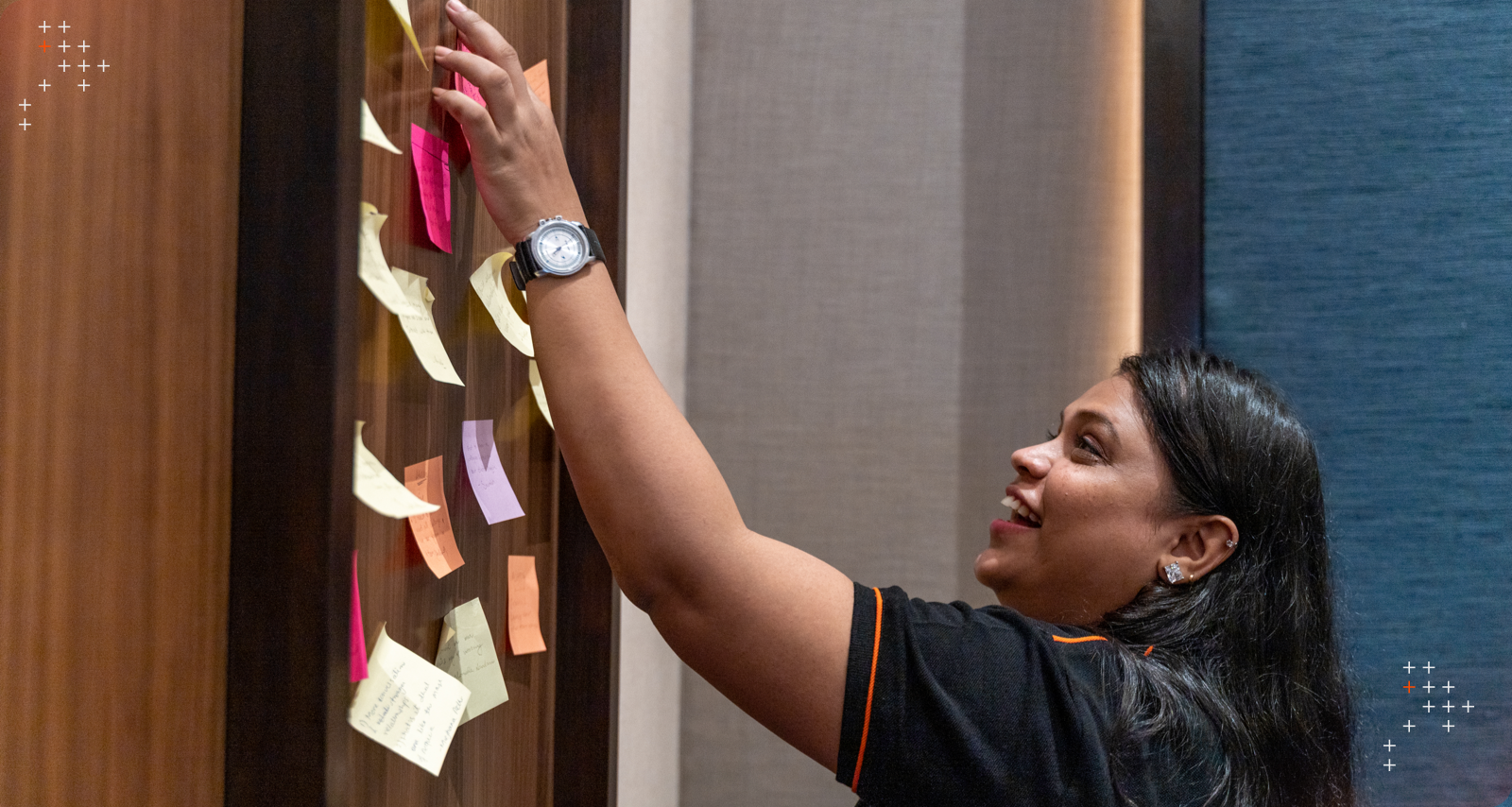Introduction
Global agency support services are all too often inward-facing. Instead of being focused on real needs with a big picture vision, most support partners get caught up in the day-to-day operational challenges, and in the process, lose sight of desired outcomes.
Here I’ll go into some of the basics of Success Teams at Axelerant, a little bit of background, and why these things matter then we'll segued into a Q and A style breakdown—an interview with one of our key Success Managers.
Keeping Eyes on the Target
Often, support partners’ roles and processes may have been created with the aim of making their own job easier, instead of being designed to benefit agencies.
The result for agencies is that direction and focus is lost. High level goals get missed altogether, and low level goals get fumbled. Communication suffers, transparency is lost, and there is no clarity around ownership of deliverables.
Agencies may have to deal with far too many touch points within their support partner’s team just to keep everyone on the same page. And in order to meet immediate demand, support teams may be relying on sourcing talent that is not the best fit for the job, which only adds to the complexity.
Working in this manner, support teams may fail to demonstrate their competency and deliver cohesive solutions. And besides the negative impact on the partnership, members of the support team also end up frustrated as they find themselves failing to deliver an effective solution and resolve key pain points for agencies, month after month.
Emergence of Success Management
At Axelerant, we identified this problem about a year ago. Our processes were centered around customer satisfaction and had to go broader: to customer success. We set out to overhaul the way we do work. This led to the emergence of success management practices, supported by effective processes, people and technologies.
Success Management
We designated Success Managers (SM’s) to always keep an eye on our agency customers’ desired business and technological outcomes. Our SM's form a single point-of-contact for our customers, coordinating with their product owner and handling all their needs, irrespective of department or function.
This frees agencies of the need to keep shepherding various teams towards delivering cohesive results. SM's own the project and its outcomes, filtering and communicating agency needs and goals across to internal teams as needed. Even when agency needs are constantly changing, SM's are able to maintain the support team’s focus on the highest priority tasks.
Processes
In terms of process, we shifted our focus from simply resolving tickets to conscientiously crafting solutions that address specific agency needs. We also brought in clarity regarding ownership of deliverables to maintain transparency at all stages.
Now, during our Partner Onboarding process, we dive deep into each agency’s business and workflow in an effort to understand their long- and short-term desired outcomes, as well as to identify the best way to integrate our teams into their existing ways of working. Establishing shared documentation, technical standards and acceptance criteria at this stage helps us eliminate any knowledge transfer gaps and minimize the risk of failure.
Only then do we begin Technical Onboarding, which begins with a detailed audit, and also includes creating the first release plan and populating the support backlog. Our processes are engineered so that support requests are captured and addressed in alignment with agency goals and within the necessary timeframes.
People
Our team also focused on ensuring that we brought the right people on board for the projects we were handling. Our hiring processes evolved towards identifying the best-fit candidates through multiple levels of testing, peer reviews, and a 90-day onboarding period.
We also focused on helping our team members grow and develop their skills by offering them continuous feedback and support with their goals, as well as opportunities to attend industry related events, further their training and give back to the community.
Technology
We use industry standard tools for communication and management, like Zoom, Slack, JIRA and Confluence. This has helped bring in transparency and streamline our workflow.
We also ensure we use the right tools to measure customer success. This, more than any other metric, gives us an accurate picture of how the team is performing in the eyes of our customers. Along with clear SLA expectations, this has helped us establish the right expectations with them and meet their needs effectively.
Building Success Management Teams: The Interview
Most companies practise “Project Management”, detailing out projects plans, dependencies, weekly reports, etc. but we found that this did not allow enough overlap with the multiple functions and aspects of a team.
At Axelerant, we now do proactive “Success Management”. This means the entire team strives toward success for our agency partner. The designation “Success Management” means that in each team, each individual handles an aspect of account servicing.
To drill down into these concepts further I sat down with one of our Axelerant Success Team leaders, Sreeni Viswanathan, who answered some key questions.

Here are my questions and the answers he gave:
“What does “success” mean in this context?”
Customer success can be measured via different parameters. At a high level, it’s assessed by measuring customer satisfaction levels (using Net Promoter Score (NPS) data), contract renewals and contract retention.
Success Management has a risk management perspective from the very beginning. It involves creating “Success Plans” a priori for mitigating risks and avoiding pitfalls and challenges that would affect the agency’s success. The success plan is formed with various “calls to action” or end objectives.
Where most support partners sign off on the contract and simply throw the project over the wall to the delivery team, at Axelerant we ensure that sales is in sync with delivery from the start. This involves understanding what initial expectations have been established, what the generic contractuals are, and so on. This is an ongoing conversation that continues with adjustments—based on learnings from the past, we know what works when it comes to contractuals, renewals, maturity and reliability of contracts based on end-goals, etc.
“What makes Axelerant Success Teams different?”
In smaller organizations, teams are often organized in this manner: Sales > PM > Project Team. The PM’s exposure to risk and interest beyond the project is limited, in goal and process structure. There’s a head-down mentality that creates silos and constrained flows of what’s important.
In medium-to-large organizations, this structure often changes to: Sales > Account Manager > PM > Project Team, where the account manager is the one focused on leveraging any opportunities and expanding the account. But this is still unidirectional and does not consider the success of the client as its primary focus
For Axelerant, the structure we follow is Sales > Success Manager from the very beginning. This SM takes care of account growth, risk mitigation, and achieving the overall high-level success of the agency.
“How Does This Work?”
Success is about people, processes, and technology, all working in harmony to produce exceptional results. Any effective success model has to take into account that change is a constant, and change is the only constant. This is why we have Success Plans that are flexible and can accommodate priority call-to-action shifts. Every time a risk is mitigated, another is formed. This is a living program.
Technology and process are evolving everyday, which necessitates continuous learning and evolution for support teams to be able to keep up.
“Agency Contracts Vs. End-client Contracts: what’s the difference?”
Whether we serve an agency or end client directly, customer success is the focus—we’re trying to grow the account and create value. But when it comes to agencies specifically, let’s look at this aspect of partnership.
When one of our agency partners continues to grow their account which we collaborate on, they don’t need to worry about capacity, because as a success management team, we ensure that the moment they bring forward an opportunity, we’ve synced with them regarding skills, capabilities—planning necessities in advance, and providing candidate selections up-front.
For agencies, we enable success minus project management; for the end-client, we offer success plus project management. This means with agency contracts, we usually don’t get involved in specific operational details which are handled on their side—our job is to make sure they’re satisfied, so we help identify needs and foster success at a high-level, ensuring resource provision and highly functioning resources.
Success Managers stay in sync via check-ins as a point of contact at different levels, e.g. with partner/end-client, with engineering team, etc. Strategically, the goal is to keep the partner or end-client involved in the right conversations and not overburdened with minute details.
Proactive risk mitigation and proactive talent planning between and regarding these things—the flow of communication across all aspects, ensuring stakeholders are on the same page—these dynamics form the crux of the Success Manager role.
Real Results
As a result of this shift in focus, our teams are now able to stay more closely aligned with our agency partners’ purpose. As we ask deeper and more meaningful questions delving into their business needs, we become better able to identify and deliver on their desired outcomes holistically, and truly work as an extended arm of their business.
This shared understanding also means that internally our teams are more closely aligned and have greater clarity on what they are working towards. They are able to ask for feedback frequently and get better visibility into risks and project metrics. This allows them to implement better tools and techniques. All this translates into better cross-functional coordination.
In order to be able to staff projects effectively, we implemented engineering capability tiers, splitting our engineering teams into multiple levels, depending on team members’ skills and experience. This enabled better flow and higher efficiency, as the right people were put on the right tasks, allowing us to set focused work targets.
In the past, there was little communication between sales and delivery once the deal was closed. Now, we have SM's who are measured on client retention. They are therefore in the best position to not only ensure success but also find opportunities to serve agencies better.
As we began working more closely with our customers, we discovered that this tighter alignment enabled us to step into new areas and offer them greater resources and strategic input, making our partnerships better and stronger at every stage.

Nathan Roach, Director of Marketing
Germany-based consumer of old world wine and the written word. Offline you can find him spending time with his wife and daughter at festivities in the Rhineland.



 We respect your privacy. Your information is safe.
We respect your privacy. Your information is safe.


